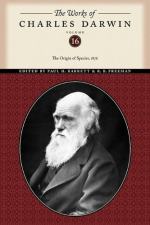
|
| Name: _________________________ | Period: ___________________ |
This test consists of 15 multiple choice questions and 5 short answer questions.
Multiple Choice Questions
1. How far are the Galapagos Islands from South America?
(a) 300 miles.
(b) 200 miles.
(c) 500 miles.
(d) 100 miles.
2. In what type of species has perfect fertility of variations been demonstrated?
(a) Mongrel.
(b) Wild.
(c) Hybrid.
(d) Domestic.
3. What does the fossil record show about natural selection?
(a) Quick change.
(b) Variations.
(c) Gradual change.
(d) Adaptations.
4. When are fossils typically preserved?
(a) During earthquakes.
(b) During storms.
(c) Between periods of geological change.
(d) In the winter.
5. What may occur if one organism changes dramatically over time?
(a) They might become a member of a different species.
(b) They might become extinct.
(c) They might become a member of a different variety.
(d) They might begin to migrate.
6. What is said about the pressure to adapt?
(a) It is equal among all species.
(b) It is dependent on the region.
(c) It is dependent on the numbers in a species.
(d) It is not equal among all species.
7. What geological process destroys fossils?
(a) Earthquake.
(b) Lightning.
(c) Erosion.
(d) Flood.
8. Where is much of the evidence proving natural selection found?
(a) Fossil records.
(b) Geological records.
(c) Ancient generations.
(d) New generations.
9. Which of the following refers to offspring with parents from two different species?
(a) Normal.
(b) Inbreed.
(c) Mongrel.
(d) Hybrid.
10. To what degree do hybrids resemble one parent?
(a) Small degrees.
(b) Extreme degrees.
(c) No resemblance.
(d) Moderate degrees.
11. What species of bees builds inefficient hives?
(a) Honeybees.
(b) Bumblebees.
(c) Hive-bees.
(d) Yellow jackets.
12. When the same species live in regions separated by large bodies of water, what is the rationale for their existence?
(a) The regions were connected at one point.
(b) The species swam at one point.
(c) Human transport.
(d) There is no rationale.
13. If natural selection is accepted, what is rejected?
(a) There is only artificial selection.
(b) Variations must be subjective.
(c) All differences must be different species.
(d) Species were created independently.
14. What do naturalists say about the situation of hybrids resembling their parents?
(a) Natural selection can explain this resemblance.
(b) Artificial selection explains this.
(c) There is no explanation.
(d) Natural selection cannot explain this resemblance.
15. How do some scientists demonstrate the differences between species and variations?
(a) Fossil records.
(b) Scientific method.
(c) Through hybrids.
(d) Natural breeding.
Short Answer Questions
1. What do species found on islands do for the theory of natural selection?
2. What is one variation found in birds that migrate?
3. What type of fossils may survive damaging geological changes?
4. Which of the following refers to organs that serve no purpose?
5. What type of species do many islands lack?
|
This section contains 418 words (approx. 2 pages at 300 words per page) |

|




